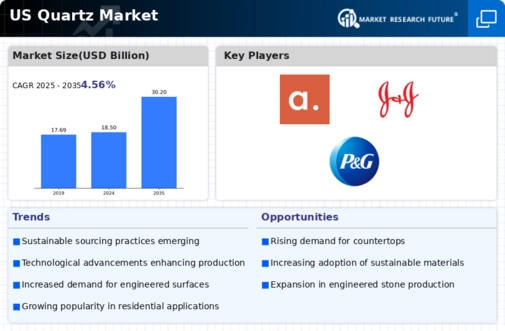The quartz market exhibits a dynamic competitive landscape characterized by a blend of innovation, strategic partnerships, and regional expansion. Key players such as Momentive (US), Saint-Gobain (FR), and Quartz Corp (US) are actively shaping the market through their distinct operational focuses. Momentive (US) emphasizes innovation in product development, particularly in high-performance quartz materials, which positions it favorably in sectors like electronics and telecommunications. Meanwhile, Saint-Gobain (FR) leverages its extensive global footprint to enhance its supply chain efficiency, thereby ensuring a steady supply of quartz products to various industries. Quartz Corp (US) is strategically focused on sustainability, aiming to reduce its environmental impact through eco-friendly mining practices and product offerings. Collectively, these strategies contribute to a competitive environment that is increasingly driven by technological advancements and sustainability initiatives.
In terms of business tactics, companies are increasingly localizing manufacturing to reduce lead times and enhance responsiveness to market demands. Supply chain optimization remains a critical focus, particularly as firms seek to mitigate risks associated with global supply chain disruptions. The market structure appears moderately fragmented, with several key players exerting influence while also facing competition from smaller, specialized firms. This fragmentation allows for a diverse range of products and innovations, catering to various customer needs across different sectors.
In October 2025, Momentive (US) announced a significant investment in a new manufacturing facility aimed at increasing production capacity for its advanced quartz materials. This strategic move is likely to enhance Momentive's ability to meet the growing demand from the semiconductor industry, which is experiencing rapid growth due to technological advancements. The investment underscores Momentive's commitment to maintaining its competitive edge through increased production capabilities and innovation.
In September 2025, Saint-Gobain (FR) entered into a strategic partnership with a leading technology firm to develop smart quartz solutions for the construction industry. This collaboration is expected to integrate advanced technologies such as IoT and AI into quartz-based building materials, thereby enhancing their functionality and appeal. The partnership reflects Saint-Gobain's proactive approach to innovation and its intent to lead in the development of high-tech construction materials.
In August 2025, Quartz Corp (US) launched a new line of eco-friendly quartz products designed for the renewable energy sector. This initiative aligns with the growing trend towards sustainability and positions Quartz Corp as a leader in environmentally responsible manufacturing. The introduction of these products not only caters to the increasing demand for sustainable materials but also enhances the company's brand reputation in a market that is progressively valuing eco-conscious practices.
As of November 2025, the quartz market is witnessing trends that emphasize digitalization, sustainability, and the integration of AI technologies. Strategic alliances are becoming increasingly pivotal, as companies recognize the need to collaborate to enhance their technological capabilities and market reach. The competitive differentiation is likely to evolve from traditional price-based competition towards a focus on innovation, technological advancements, and supply chain reliability. This shift suggests that companies that prioritize these aspects will be better positioned to thrive in the evolving landscape of the quartz market.














Leave a Comment